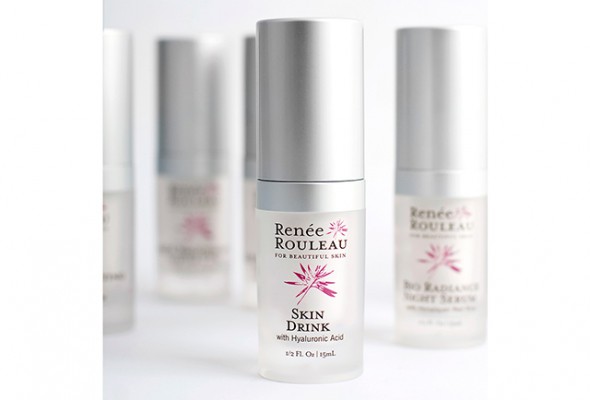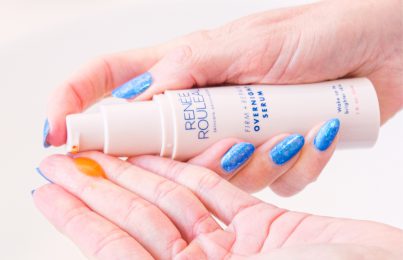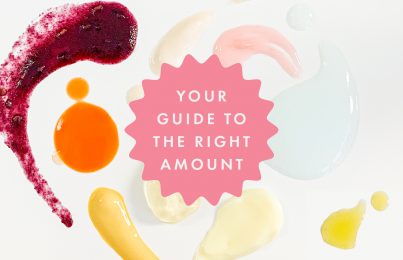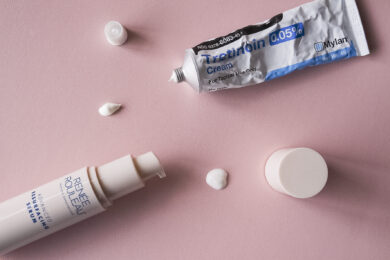A skin serum is a skin care product that contains a higher concentration of active ingredients and usually comes in a gel or creamy gel form. It is meant to be used under a moisturizer or mask to give a boost of results to the skin.
If you have two serums and they each offer different benefits that your skin needs, can mixing them together and applying to the skin give you enhanced results?
The answer is yes! I recommend layering them on one at a time versus actually mixing them together in the palm of your hand.
Here are two examples as to how using two serums can offer you extra skin benefit:
-Let’s say you’re breaking out, but your skin is feeling dehydrated too. After cleansing, layer on a coat of an oil-free serum that contains hyaluronic acid like Skin Drink. (Read about the benefits of hyaluronic acid.) Then layer on a thin coat of Anti Cyst Treatment to the areas that are breaking out. Let dry and the follow with an oil-free moisturizer like Sheer Moisture. (Note: While Anti Cyst Treatment is formulated for spot treating painful cystic blemishes, it’s also really beneficial for preventing ALL TYPES of blemishes when used in areas prone to acne.)..
– If I have a new client and she mentions that she has an expensive vitamin C serum from another skin care line that she can’t use very often because it stings and irritates her skin (which is common with vitamin C serums), I will suggest this instead. Despite having our Cosmetic Donation Program, where we encourage our clients to donate their gently-used products if they are not getting use from them, understandably some clients don’t want to give away really expensive products. So in this case I’ll suggest they purchase our no-sting Vitamin C&E Treatment since it’s excellent for sensitive skin and layer it on first, then layer on a few drops of the other vitamin C serum over it. By putting a first layer of the gentler formula, the second product will be less likely to cause irritation since it’s not directly touching the skin. Plus, when it comes to using a face serum, there are many great forms of vitamin C available that offer excellent antioxidant benefits, and since many lines may use different types than what our Vitamin C&E Treatment uses, she actually is giving her skin a more powerful dose of antioxidant protection. So this works out very well to layer, yet reduce the skin sensitivity.
New Beauty Magazine recently had an article about the common types of vitamin C and here is what they reported.
L-Ascorbic Acid – is not very stable and can lose its effectiveness quickly.
Magnesium Ascorbyl Phosphate – a water-soluble gentle form of vitamin C ester and is ideal for those with sensitive skin.
Ascorbyl Palmitate – the fat-soluble form of vitamin C which allows it to penetrate quicker and deeper.
Read: Five Skin Care Ingredient Myths You Need to Know
What ingredients should not be used together?
Some ingredients should not be used together as they can irritate the skin, cause negative reactions, or cancel out the effects of both. They can be used at different times of the day, just not at the same time.
-Avoid mixing retinol product with Benzoyl Peroxide.
-Avoid mixing retinoids or hydroquinone with glycolic acid.
-Avoid mixing vitamin C with copper peptides.
One other tip worth noting: It’s best never to mix your sunscreen and your moisturizer together because then you are not getting the full SPF number listed on the bottle. If your skin is in need of extra hydration, using an extra moisturizing serum layered under your moisturizer along with your daily vitamin C serum will do the trick. Getting the full benefit from your sunscreen is important considering UV exposure is the #1 cause of premature skin aging.
Read: My Five Favorite Tips for Protecting Your Skin from the Sun
Which products are right for your skin? See our nine skin types and get products recommended.
Need expert advice from a licensed esthetician? Schedule My Skin Prescription to get personalized advice in person, over the phone or via Skype or Facetime.
For more expert skin advice, check out Skin Source–the A-Z guide on all things skin. Also sign up for our skin tip e-newsletter, follow Renée Rouleau on Twitter and join the discussion on our Facebook page. You’ll be your own skin care expert in no time!
Celebrity Esthetician & Skincare Expert
As an esthetician trained in cosmetic chemistry, Renée Rouleau has spent 30 years researching skin, educating her audience, and building an award-winning line of products. Her hands-on experience as an esthetician and trusted skin care expert has created a real-world solution — products that are formulated for nine different types of skin so your face will get exactly what it needs to look and feel its best. Trusted by celebrities, editors, bloggers, and skincare obsessives around the globe, her vast real-world knowledge and constant research are why Marie Claire calls her “the most passionate skin practitioner we know.”




Comments:
I saw an article where you said you do not recommend combining products in your palm such as buffet and HA. I was just curious as to why that is? Does it take away from them working as well as they can in layers? Thanks PS you will not let me comment with out a website and I don’t have one.
Posted By: Cece |
HI, Cece! Even if the ingredients in two different serums can technically be combined, you still run into the issue of dilution.
Posted By: Renée Rouleau |
Is it okay to use AHAs with peptides simultaneously?
Posted By: Ana |
Sure, that shouldn’t be a problem to use them together.
Posted By: Renée Rouleau |